The foundation of Chinese medicine is based on careful clinical observations and is presented in the framework of the concept of the basic forces yin and yang. These two cosmic forces are the two basic principles around which everything revolves.
Ancient Chinese Cosmology states that the universe was created through the interplay of natures basic duality, the active, light, dry, warm, positive masculine yang and the passive dark, cold, moist negative Yin.
If the yin-yang balance is maintained, good health and long life will persist. Disregard of this balance leads to illness.
‘Chi’ is the vital force behind all life processes and ‘yin’ and ‘yang’ are the dual expressions of ‘Chi’.
‘Chi’ comes into body at birth and leaves it at death. During a person’s life time, it flows in a specific and continuous pattern in the forms of yin and yang inside a system of channels called meridians into the human body.
The meridians are either yin or yang depending upon the way in which ‘Chi’ flows. If it flows freely and correctly through each of the twelve meridians, then the body is kept in balance and in good health.
There are twelve paired main channels or meridians and two central unpaired channels. They are six in the upper extremities or arms and six in the lower extremities or legs. Out of these six paired meridians in the arms, three are yin meridians and three are yang. Similarly there are three yin and three yang meridians in the legs.
In the arms the three yin meridians are lung (L) Pericardium (P) and Heart (H) located on the palmar surface of the arm. On the dorsal side, exactly opposite to lung meridian is Large Intestine meridian (LI). In the centre, exactly opposite to the Pericardium meridian is located Triple Warmer (TW) meridian and similarly exactly opposite to the heart meridian is the location for Small Intestine (SI) meridian.
There are three yin meridians on the inner side of a leg and thigh. They are spleen (SP), liver (Liv.) and kidney (K) meridians. On the front and outer aspect of the leg and thigh corresponding to spleen meridian on the outer and front is the stomach (St) meridian. Behind the stomach (St) meridian is the gall bladder (GB) meridian that lies exactly opposite to liver meridian and last one is the urinary bladder (UB) meridian which corresponds with the kidney meridian.
Each meridian starts from or ends into a particular internal organ and runs on the surface and makes a complete inner or outer circle to maintain the flow of energy through the particular channel.
There is also internal connection between the two channels to maintain the energy flow. The yin and yang channels of the same level on the arm or leg have this type of connection and are called coupled or paired channels. They are
1. Lung (L) and Large Intestine (LI)
2. Pericardium (P) and Triple warmer (TW)
3. Heart (H) and Small Intestine (SI)
4. Spleen (SP) and Stomach (St)
5. Liver (Liv.) and Gall bladder (GB)
6. Kidney (K) and Urinary bladder (UB)
There are two central unpaired channels or meridians. In the midline on the front side is conceptional vessel (CV) meridian. It is also called as Ren meridian which is yin meridian and on the backside just along the vertebral column in the centre is the unpaired meridian called governing vessels meridian (GV) or Du meridian.
The flow of energy certain rules in relation to time also. The rule pertaining to this is known as the midday midnight law. If the meridians are worked upon in their related time, the best results are achieved. The time relation to the circulation of vital energy through various organs and meridians will be given with the description of each meridian.
Lung meridian (Lu)
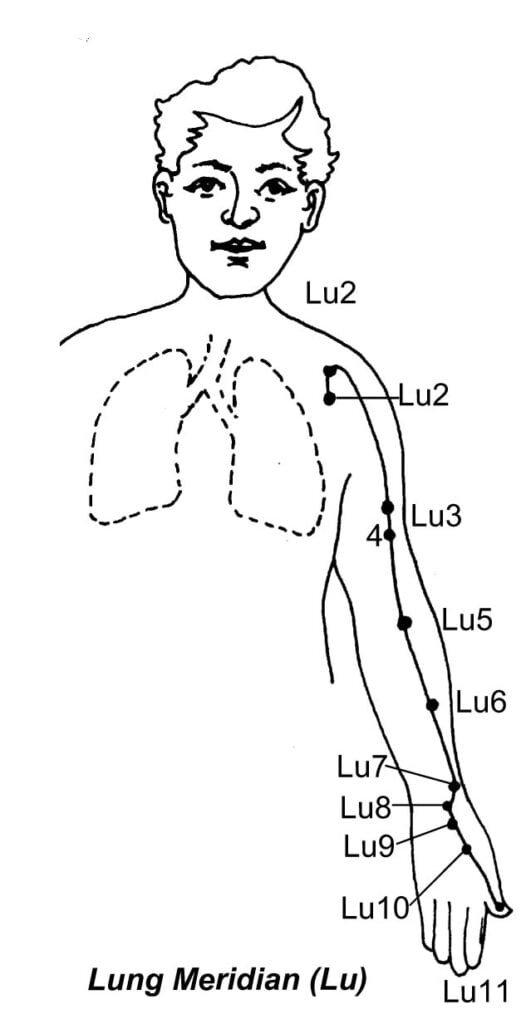
This meridian is yin and is coupled with the large intestine meridian which is yang. The lungs regulate breathing and may be subjected to conditions such as bronchitis, asthma, and emphysema. They also govern the skin. Disorders arising from this meridian are infections of the sinuses, throat and chest, asthma, pain in the shoulder or forearm, skin disorders like allergy, dermatitis and psoriasis.
Total number of points: 11 Starting point : Inter costal space below the clavicle near the carquoid process.
Terminal point: On the lateral side of the thumb close to the corner of the nail. Flow time of vital energy—3 AM to 5 AM
Path way: After originating from the stomach, it descends to, connect with the large intestine. It ascends up towards the diaphragm and enters its principal organ, the lung. From here it moves upwards and outwards towards the first intercostal space to become superficial.
Large intestine Meridian (Lu)
This meridian is yang and complementary to the lung meridian which is yin. The large intestine is responsible for the elimination of waste material from the body. If this organ is not functioning correctly, it can cause a build up of toxins in the body. Due to its close link with lung meridian, either of these two meridians not working efficiently will affect the other.
Malfunctioning of the LI meridian can lead to nose and throat problems, a greasy or spotty skin, painful shoulder, tennis elbow, tooth ache, infantile indigestion, rheumatoid arthritis, diabetes., hypertension, wrinkles on face and acne vagaries, epistaxis, skin disorders like psoriasis and dermatitis, hemiplegia, diarrhoea with griping and other abdominal pain, head ache, and painful conditions of the eye.
Total number of points : 20
Starting Point : Tip of the radial side of the index finger.
Terminal point : Between Masolabial groove (Below the nose)

Flow time of vital energy : 5 AM to 7 AM
Pathway : Starting on the radial side of the index finger, this channel passes over the first dorsal intermetacarpal space, runs up the arm and neck and ends below the nose as shown.
Stomach Meridian (St)
This meridian is yang and is complementary to the spleen meridian which is yin. The stomach is the organ of the body where food and drink are broken down to simpler substance for the absorption of vital nutrients into the body. The spleen is responsible for helping this process therefore the two meridians work closely together.
Disharmony of this meridian can lead to problems associated with the stomach, eyes, sinuses, throat, spleen and pancreas, acute and chronic conjunctivits, facial nerve paralysis, rhinitis and epistaxis, gastro-enteritis, menstrual irregularities in females, urinary disorders , diseases of knee joints, hypertension, diabetes, varicose veins, improves immunity and effective in tonification of the body in debility, fatigue, weakness and hypotension.
Total number of points : 45
Starting point: Beneath the eye and then it moves up to the temple before continuing down the body.
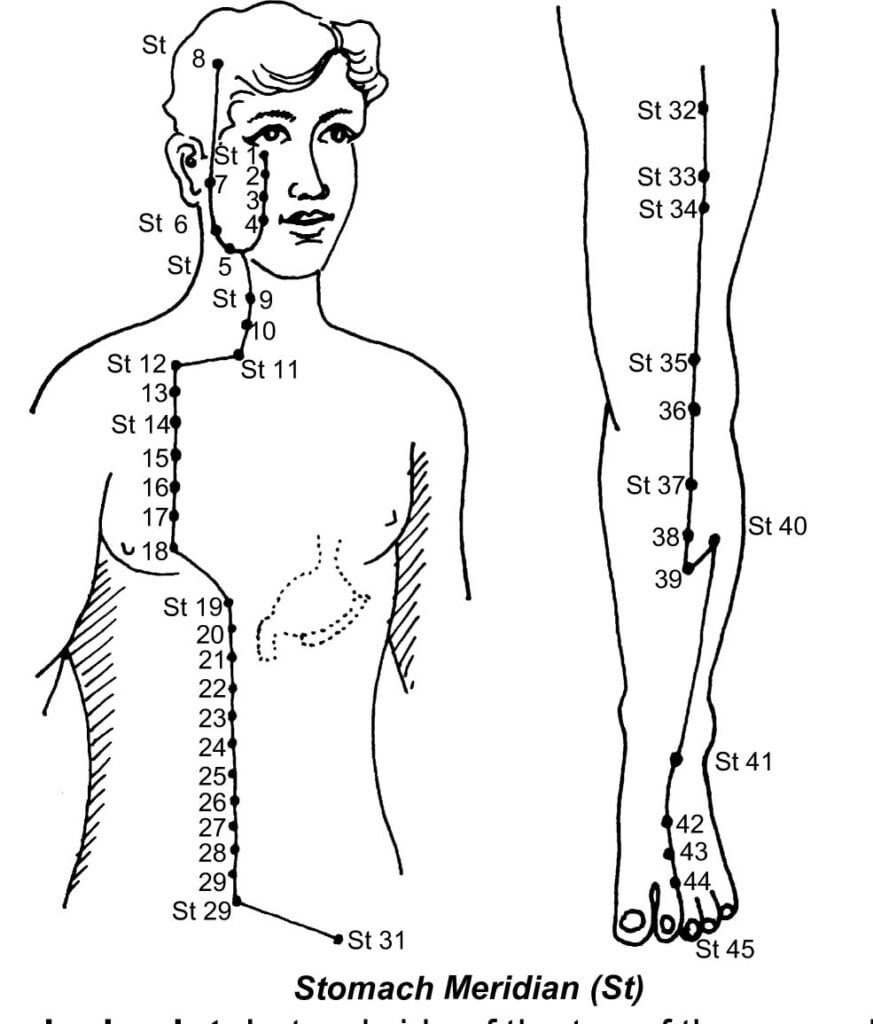
Terminal point: Lateral side of the top of the second toe near the nail.
Flow time of vital energy : 7 AM to 9 AM
Path way: This meridian has a descending flow of energy. It starts beneath the eye and moves up to the temple before continuing down the body to the top of the second toe.
Spleen meridian (Sp)
This meridian is yin and is coupled with the stomach meridian which is yang. The spleen encompasses a wide range of functions. It is closely linked to the stomach, helping in the transformation and absorption of food materials into energy and blood.
The main disorders associated with this meridian are fatigue, digestive problems, diarrhoea and metabolic problems, bowel disturbances, retention of urine, disease of liver, spleen and kidney, diabetes, menstrual disorders in females and obesity.
Total number of points : 21
Starting point : Medial side of the big toe.
Terminal point : Side of the breast under armpit.
Time for stimulation 9 to 11 AM
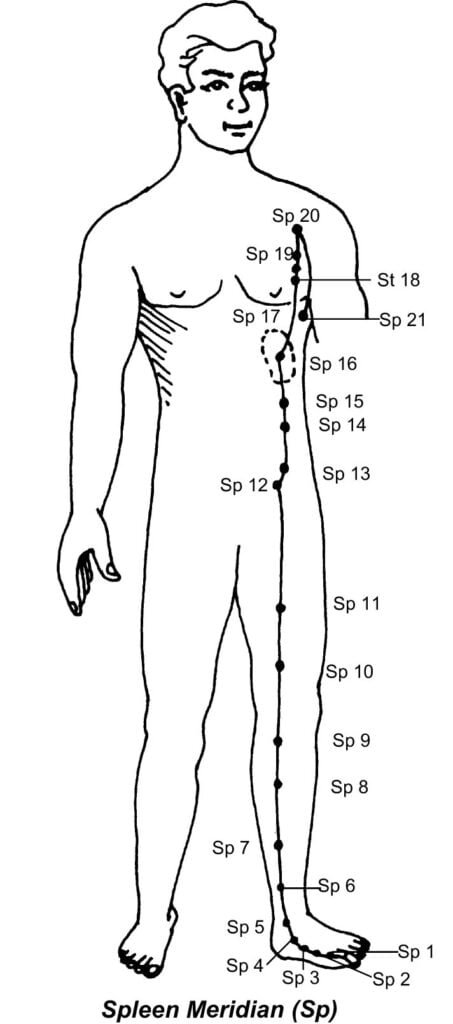
Path way: This meridian has an ascending flow of energy which starts in the centre of the back of the big toe, runs up the leg, through the body and ends on the side of the breast, under the armpit.
Heart meridian (H)
The heart meridian is yin and is coupled with the small intestine which is yang. A person suffering from angina frequently experiences quiet severe pain along this path way.
Malfunctioning of the heart meridian can appear as pain and weakness in the arm or wrist, skin problems angina, breathlessness, heart attacks, insomnia, palpitation and anxiety.
The heart is connected with the tongue and certain speech defects can be successfully treated by working this meridian.
Total number of points : 9
Starting point : Centre of Axilla.
Terminal point : lateral side of the little finger proximal to the corner of nail
Flow time of vital energy : 11 AM to 1 AM
Path way: This meridian has a descending flow of energy which runs from the chest to the hand.
Small intestine meridian (Si)
This meridian is yang and complementary to the heart meridian which is yin.
Malfunctioning of this meridian can cause many kinds of musculo-skeletal pain such as painful shoulder, cervical- spondylosis, stiff neck and tennis elbow. Other disorders include digestive and urinary problems, hearing difficulties tinnitus and swollen lymph glands in the throat.
Total number of points : 19
Starting point : Corner of the nail of the little finger.

Terminal point : A point in front of the ear
Flow time of vital energy: 1 PM to 3 PM.
Path way: It has an ascending flow of energy which starts on the little finger, runs up the arm, over the shoulder, along the neck to the outer corner of the eye and terminates just in front of the ear.
Urinary Bladder Meridian (ub)
The bladder meridian is yang and complementary to the kidney meridian which is yin. It is one of the longest meridians in the body.
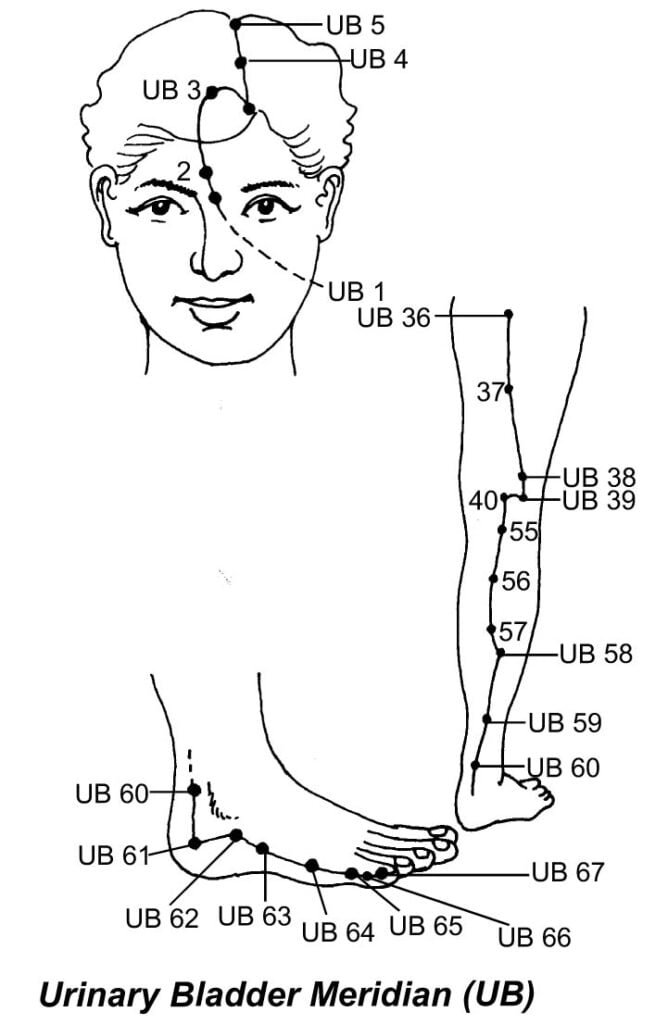
Disorders associated with this meridian include eye weakness, headache, sinus problems, cystitis, tuberculosis of the bone, leurisy, haemorrhoids, cramps of calf muscles, impotence, retained placenta.
Total number of points : 16
Starting point : Inner corner of the eye
Terminal point : Lateral side of the tip of the little toe.
Flow time of vital energy : 3 PM to 5 PM
Path way: This meridian has a descending flow of energy. It starts at the inner corner of the eye passes over the head and forks at the base of the neck. One branch runs down along the spine to the coccyx. The other descends to the inner most edge of the scapula and continues down parallel to the first branch. Both branches continue across the buttocks down the back of the leg, joining into one at the back of the knee and ending on the outer edge of the little toe.
Kidney Meridian (K)
This meridian is yin and is coupled with the bladder meridian which is yang. The kidneys are the foundations for yin and yang.
Disorders most often associated with the kidney meridian include brittle and soft bones, back pain, asthma, phlebitis, varicose veins, uterus and prostate problems and bladder weakness.
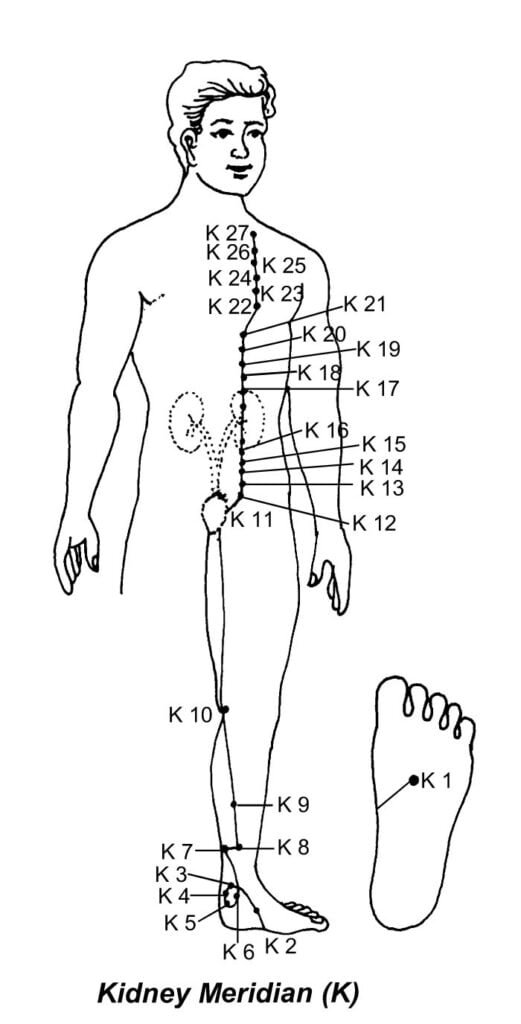
Total number of points : 27
Starting point : On the side of the foot at the junction of anterior one third and posterior two third of the sole.
Terminal point : Intraclavicular region (Breast bone)
Flow time of vital energy : 5 PM to 7 PM
Path way: This kidney meridian has an ascending flow of energy. It starts on the sole of the foot and runs up the back of the leg to the front of the body. From there it ascends in a straight line to the breast bone.
Pericardium meridian (p)
This meridian is yin and is coupled with the triple warmer meridian which is yang.
Disorders mostly related to this meridian are very similar to those of the heart meridian as Pericardium is the outer covering of the heart that contains a fluid which prevents the heart from shocks and helps to work smoothly. It is believed that many disorders associated with the heart are treated effectively by working on this meridian.
Total number of points : 9
Starting point : On the lateral side of nipple of the breast.
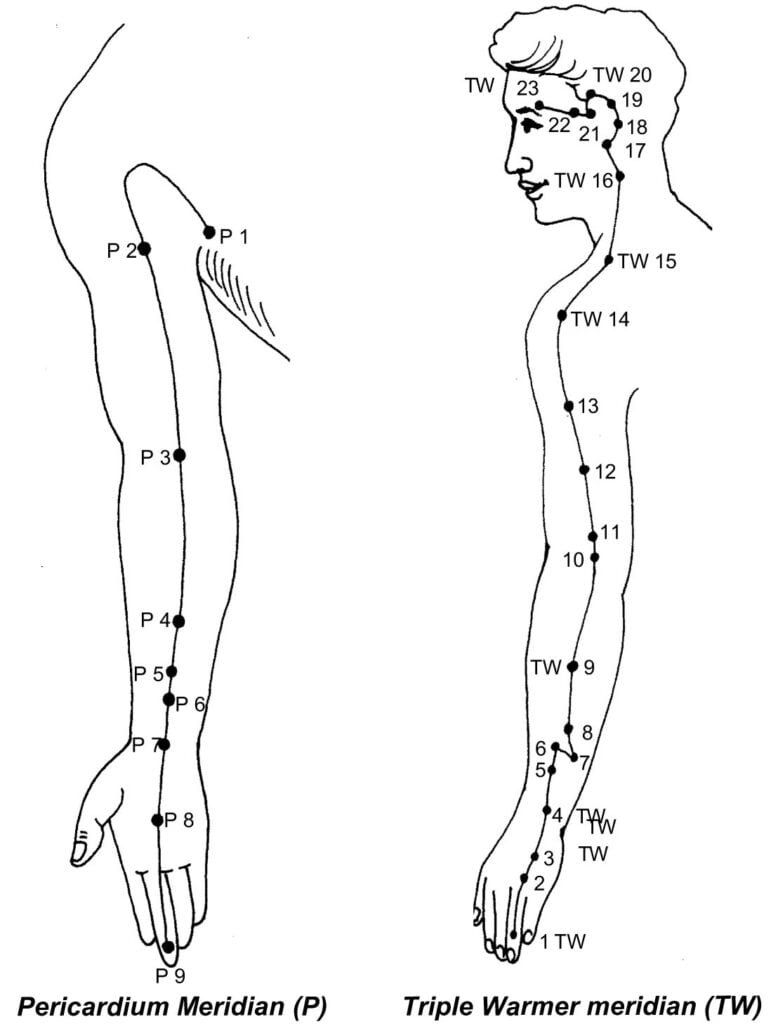
Terminal point : Top of middle finger.
Flow time of vital energy : 7 PM to 9 PM
Path way: It has a descending flow of energy which starts near the nipple and descends down the arm to the back of the middle finger.
Triple Warmer Meridian (TW)
This meridian is yang and is complementary to the pericardium meridian which is yin. Though it has no direct link with any physical organ but is supposed to affect the efficiency of other eleven meridians.
The term triple warmer points to the three burning cavities of the body namely chest, abdomen and pelvis. In a healthy body all these three areas are at same touch temperature.
The main function of it is to regulate the body temperature. It also balances the autonomic nervous system and controls the pituitary gland the master gland of the body. Its malfunctioning leads to stiffness and pain in the arm and wrist and pain associated with the eye and the ear.
Total number of points : 23
Starting point : Corner of the nail of ring finger.
Terminal point : Lateral end of the eye brow.
Flow time of vital energy : 9 PM to 11 PM
Path way: This meridian has an ascending flow of energy which starts on the back of the ring finger, travels up the arm and ends above the outer corner of the eye.
Gall Bladder Meridian (GB)
This meridian is yang and is complementary to the liver meridian which is yin. The Gall Bladder stores and secretes the bile produced by the liver, so any disorder in the liver will affect this meridian.
Disorders most often associated with this meridian are head aches, migraine, neck tension, eye problems, painful shoulders, asthma, arthritic hips and knee and menstrual problems in females.
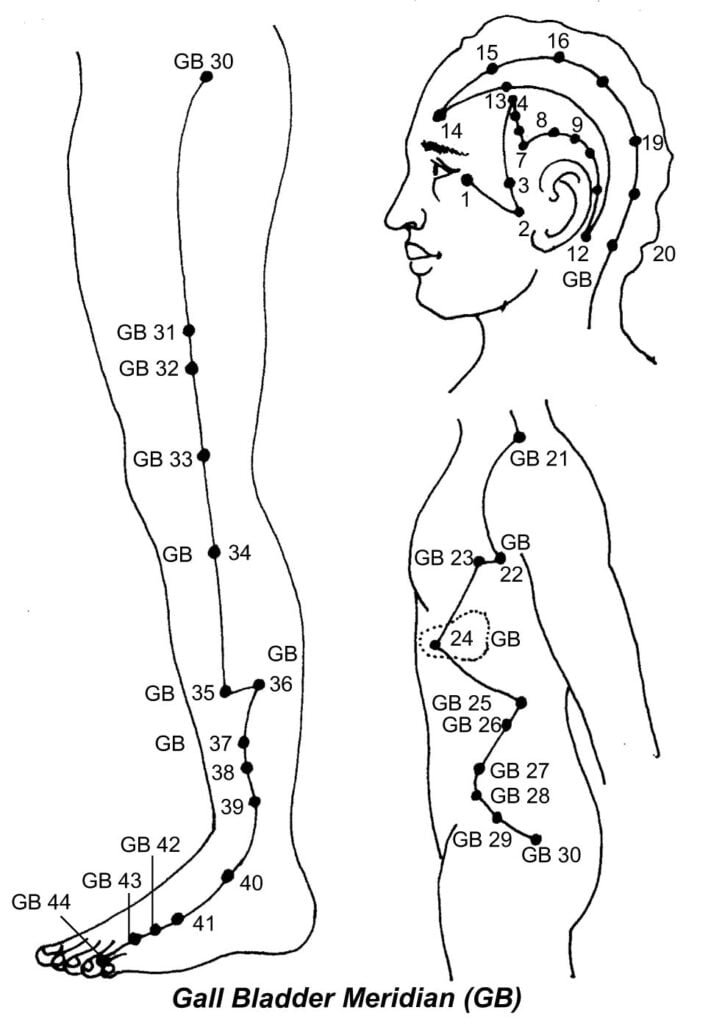
Total number of points : 44
Starting point : Lateral Side of the eye, on the temples.
Terminal point : Tip of the fourth toe.
Flow time of vital energy : 11 PM to 1 PM
Path way: This meridian has a descending flow of energy and runs from the temple over the head and down the side of the torso to the back of the fourth toe.
Liver Meridian (Liv)
The liver meridian is yin and is coupled with the gall bladder meridian which is yang. Malfunctioning of the liver meridian shows disorders in the digestive system as indigestion, nausea, flatulence. Excessive intake of alcohol, chocolates, coffee, drugs may over strain the liver and result in headaches, and arthritic condition. The liver affects the eyes and if in a state of toxicity, black dot may appear in front of the eyes. It is also associated with menstruation and any malfunctioning of the liver may result in irregular and painful periods, fluid retention, pre menstrual tension, poor libido, thrush, uterus and prostate problems. In a male it can be responsible for a low sperm count.
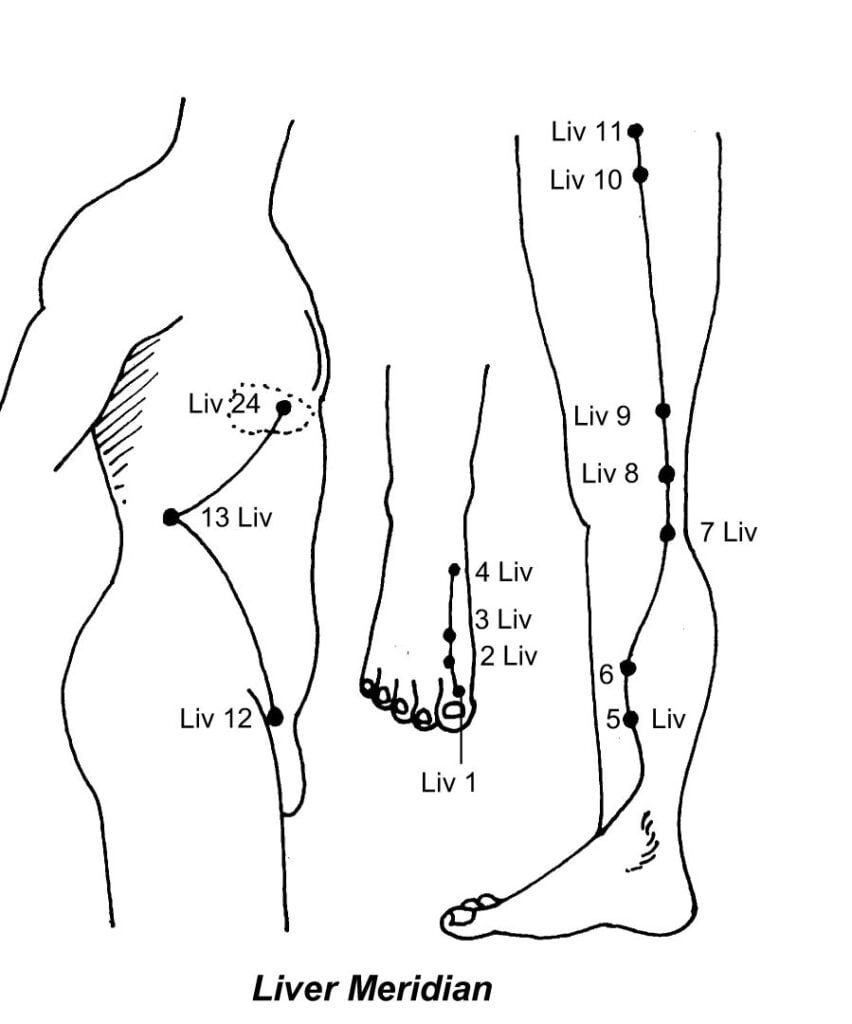
Total number of points : 14
Starting point : Dorsum of the big toe.
Terminal point : Just below the nipple on the lower part of the breast bone.
Flow time of vital energy : 1 AM to 3 AM
Path way: It has an ascending flow of energy and starts on the back of the big toe and ascends medially up the leg to the genital region. From there it continues to ascend to just below the nipple on the lower part of the breast bone.
Governing Vessels Meridian (The Du Channel)
The meridian is not linked to any organ but it possesses a governing influence on the yang channels of the body.
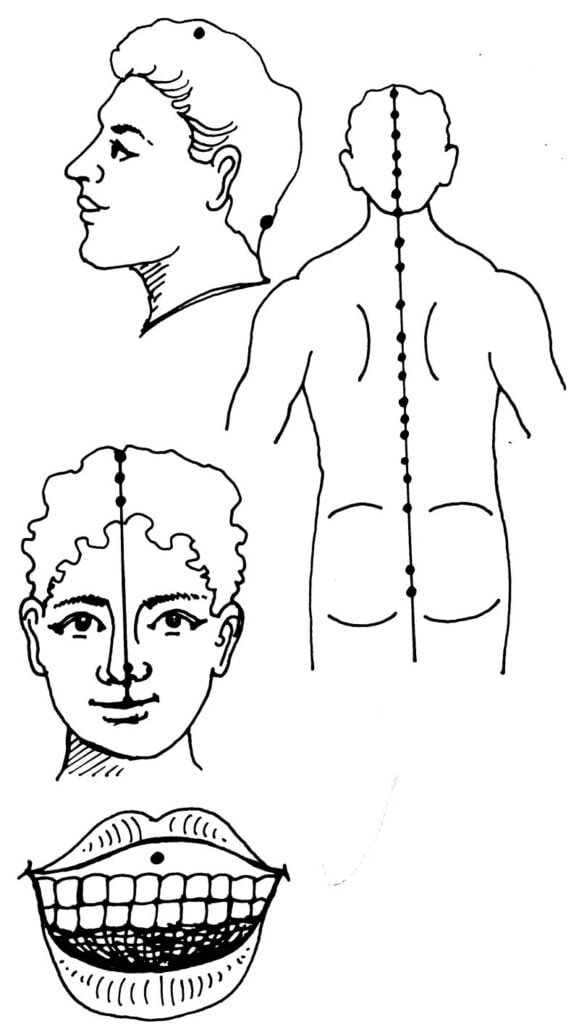
Disorders related to this meridian are renal colic, sciatica, impotence, enuresis, piles, jaundice, fever, heatstroke, severe backache, anxiety, epilepsy, loss of memory, insomnia, facial paralysis.
Total number of points : 28
Starting point : In between the tip of coccyx and the anus.
Terminal point : Junction of the upper lip and gum.
Path way : It starts from the point in between the coccyx and the anus and runs exactly in the posterior midline along the spinous process of the vertebral column and reaches midline of skull. Then it winds round the scalp and forehead and descends down to end in between the junction of the upper lip and the gum.
The Conceptional vessels Meridian
(The Ren Channel)

This meridian is not associated with any organ but it posses yin character and has a controlling influence over all the yin meridians of the body. It is so called because of its special control over the reproductive functions and as Ren channel because of anterior midline position in the body.
Disorders linked with this meridian are all Genito urinary disorders, abdominal disorders, diseases of breast, painless child birth, oedema, heart and lung disorder, menstrual disorders, spermatorrhoea.
Total number of points : 24
Starting point : In the centre of perineum in front of the anus.
Terminal point : Middle of mentolabial sulcus.
Path way : This meridian originates in the centre of Perineum in front of the anus and ascends along the anterior midline of the abdomen, chest, and neck and ends at the mentolabial sulcus by dividing in two inner branches which go to both eyes and brain.

